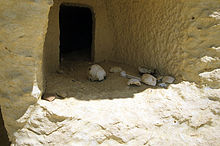 View of one of the two bitter lakes. | ||
| el-Baḥrein · البحرين | ||
| Governorate | Maṭrūḥ | |
|---|---|---|
| height | 5 m | |
| no tourist info on Wikidata: | ||
| location | ||
| ||
El-Bahrain (Arabic:البحرين, al-Baḥrain, „the two lakes“) Is an abandoned depression and archaeological site south of the Darb Siwa about 30 kilometers southeast of el-ʿArag and 30 kilometers west of en-Nuweimisa.
getting there
For the way from Darb Siwa to the oasis you need an all-terrain four-wheel drive vehicle.
For the formalities for such a trip, refer to the information in the article about the Darb Siwa approach.
background
As the name suggests, the depression consists of two lakes lying one behind the other in an east-west direction. Both lakes are above sea level, the western lake is about 6 kilometers long, the eastern one about 5.5 kilometers. The landscape is similar to that of en-Nuweimisa, only the lakes are larger here.
How el-ʿArag this oasis was inhabited at least from Greco-Roman times to Christian times. El-Baḥrein was probably an outpost of the trade route to in Ptolemaic times Siwa.
The research history is in the article about el-ʿArag shown. Gerhard Rohlfs and Georg Steindorff only pass the oasis without visiting it. There are only descriptions of Wilfred Edgar Jennings-Bramly and Klaus P. Kuhlmann.
In February 2003, an Italian mission led by Paolo Gallo from the University of Turin discovered a small, approximately 20-meter-long, decorated temple with six pillars, which was dedicated to the god Amun. The oldest part is a small shrine that Nectanebo I (30th ancient Egyptian dynasty, 380–361 BC) had built. This temple revealed the old name of this valley: Imespep.
Tourist Attractions




Two burial mounds at the northeast end of the westernmost of the two salt lakes still bear witness to the former settlement. There are around 50 rock graves here. The graves are undecorated and robbed. The only finds today are some bones.
Few finds prove the use in a long time. De Cosson calls a shaving stone made of flint. Fragments of ancient, but not prehistoric, ceramics were also found.
literature
- : Notes on the Baḥrēn, Nuwemisah, and el-Aʿreg Oases in the Libyan Dessert. In:Journal of Egyptian Archeology (JEA), ISSN0075-4234, Vol.23 (1937), P. 226 f., Panels XXI, XIII.3 (entire article p. 226–229).
- : The Ammoneion: Archeology, History and Cult Practice of the Oracle of Siwa. Mainz: from Zabern, 1988, Archaeological publications; 75, ISBN 978-3-8053-0819-9 , P. 89 f., Panels 43.a, 46.d, 47.d, 52.a.
- Sailhan, Michel: Pharaonic temple discovered in Egypt’s desert. In: Middle East Online dated February 21, 2003. Report on the discovery of the temple.


